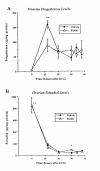Activation of the kinin system in the ovary during ovulation: role of endogenous progesterone
- PMID: 12014992
- PMCID: PMC111191
- DOI: 10.1186/1472-6793-2-7
Activation of the kinin system in the ovary during ovulation: role of endogenous progesterone
Abstract
Background: Previous work by our group and others has implicated a role for kinins in the ovulatory process. The purpose of the present study was to elucidate whether endogenous progesterone, which is an intraovarian regulator of ovulation, might be responsible for induction of the kinin system in the ovary during ovulation. The gonadotropin-primed immature rat was used as the experimental model, and the role of endogenous progesterone was explored using the antiprogestin, RU486.
Results: The results of the study revealed that RU486 treatment, as expected, significantly attenuated ovulation. Activity of the kinin-generating enzyme, kallikrein, was elevated in the ovary in control animals prior to ovulation with peak values observed at 4 h post hCG, only to fall to low levels at 10 h, with a recovery at 20 h post hCG. RU486 treatment had no significant effect on ovarian kallikrein activity as compared to the control group. Total ovarian kininogen levels in control animals increased significantly at 12-14 h after hCG - coinciding with initiation of ovulation. Thereafter, ovarian kininogen levels fell to low levels at 20 h, only to show a rebound from 24-38 h post-hCG. RU486 treatment had no significant effect on the rise of total ovarian kininogen levels from 12-14 h after hCG; however, from 30-40 h post hCG, RU486-treated animals had significantly higher total ovarian kininogen levels versus control animals, suggesting that endogenous progesterone may act to restrain elevations of kininogens in the post-ovulatory ovary. This robust elevation of ovarian kininogen levels by RU486 was found to be primarily due to an increase in T-kininogen, which is a potent cysteine protease inhibitor.
Conclusions: Taken as a whole, these results suggest that endogenous progesterone does not regulate kallikrein activity or kininogens prior to ovulation, but may provide a restraining effect on T-kininogen levels in the post-ovulatory ovary.
Figures





Similar articles
-
Characterization of the kinin system in the ovary during ovulation in the rat.Biol Reprod. 1992 Dec;47(6):945-51. doi: 10.1095/biolreprod47.6.945. Biol Reprod. 1992. PMID: 1493183
-
Effects of progesterone and anti-progesterone RU486 on ovarian 3 beta-hydroxysteroid dehydrogenase activity during ovulation in the gonadotrophin-primed immature rat.J Reprod Fertil. 1993 Jan;97(1):167-72. doi: 10.1530/jrf.0.0970167. J Reprod Fertil. 1993. PMID: 8464007
-
The relationship between ovarian progesterone and proteolytic enzyme activity during ovulation in the gonadotropin-treated immature rat.Biol Reprod. 1992 Feb;46(2):309-13. doi: 10.1095/biolreprod46.2.309. Biol Reprod. 1992. PMID: 1536908
-
Interaction between ovarian and adrenal steroids in the regulation of gonadotropin secretion.J Steroid Biochem Mol Biol. 1992 Mar;41(3-8):495-513. doi: 10.1016/0960-0760(92)90375-s. J Steroid Biochem Mol Biol. 1992. PMID: 1562521 Review.
-
Mifepristone and ovarian function.Clin Obstet Gynecol. 1996 Jun;39(2):486-97. doi: 10.1097/00003081-199606000-00022. Clin Obstet Gynecol. 1996. PMID: 8734013 Review.
Cited by
-
Regulated expression of Gemin5, Xrn1, Cpeb and Stau1 in the uterus and ovaries after superovulation and the effect of exogenous estradiol and leptin in rodents.Mol Biol Rep. 2019 Apr;46(2):2533-2540. doi: 10.1007/s11033-019-04606-z. Epub 2019 Jan 28. Mol Biol Rep. 2019. PMID: 30689188
-
Changes in bradykinin and bradykinin B(2)-receptor during estrous cycle of mouse.Acta Histochem. 2011 Jul;113(4):436-41. doi: 10.1016/j.acthis.2010.03.008. Epub 2010 May 23. Acta Histochem. 2011. PMID: 20546864 Free PMC article.
References
-
- Bhoola KD, Figueroa CD, Worthy K. Bioregulation of kinins, kallikreins, kininogens and kinases. Pharmacol Rev. 1992;44:1–80. - PubMed
-
- Greenbaum LM, H Okamoto. T-kinin and T-kininogen. Methods Enzymol. 1988;163:272–282. - PubMed
-
- Clements JA. The glandular kallikrein family of enzymes: tissue specific expression and hormonal regulation. Endocrine Rev. 1989;10:393–419. - PubMed
-
- Okamoto H, Greenbaum LM. Pharmacological properties of T-kinin. Biochem Pharmacol. 1983;32:2637–2638. - PubMed
-
- Moreau T, Esnard F, Gutman N, Degand P, Gauthier F. Cysteine-proteinase-inhibiting function of T-kininogen and of its proteolytic fragments. Eur J Biochem. 1988;173:185–190. - PubMed
Publication types
MeSH terms
Substances
LinkOut - more resources
Full Text Sources

